Tractor-drawn aerials, often called TDAs or tillers, have been around in one form or another for more than a century, and while their popularity ebbed with the development of single-chassis, mid-mount, and rear-mount aerials, it never completely died.
Fire departments across the country continue to use TDAs, citing their handy maneuverability, storage capacity, and tactical placement capabilities on fire scenes.
Tractor-Drawn Aerials Continue to Enjoy Resurgence
Randy Hummer, aerial account manager for REV Fire Group’s Spartan Emergency Response/Ladder Tower products, says Spartan ER offers the QX-100 and AH-105 LT models of TDAs. “Large urban cities like Philadelphia (PA), Los Angeles City (CA), San Francisco (CA), and Atlanta (GA) continue to operate TDAs as their primary aerial apparatus, while mid-size cities like Savannah (GA), Dallas (TX), San Marcos (TX), and Columbus (OH) have mixed aerial/platform fleets, depending on response areas,” Hummer says. “We’re seeing more inquiries for TDAs from fire departments as first-time TDA users. They may be looking at TDAs to reduce purchase costs of multiple units, address manpower requirements, or simply need an apparatus with more storage space for equipment.”
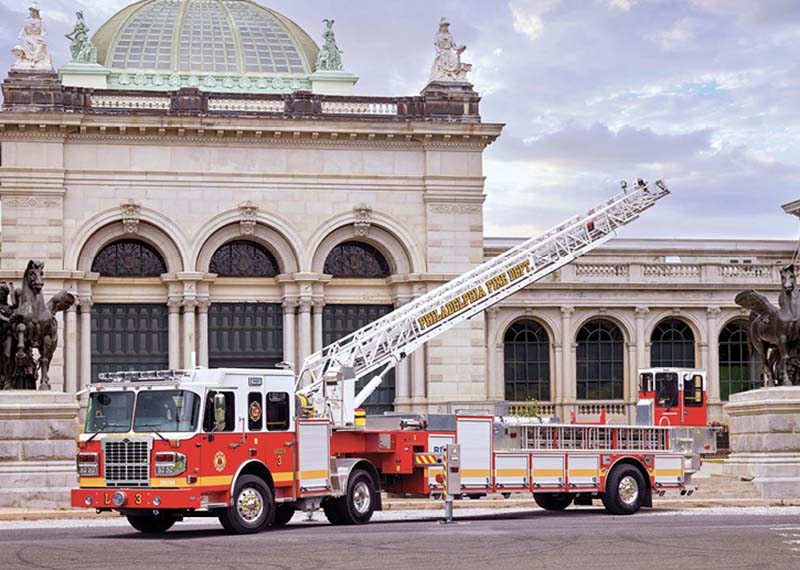
1 Spartan Emergency Response built this Ladder Tower™ QX-100 tractor-drawn aerial with a 55-foot travel length and 14-foot jack spread for the Philadelphia (PA) Fire Department. (Photos 1-2 courtesy of Spartan Emergency Response.)
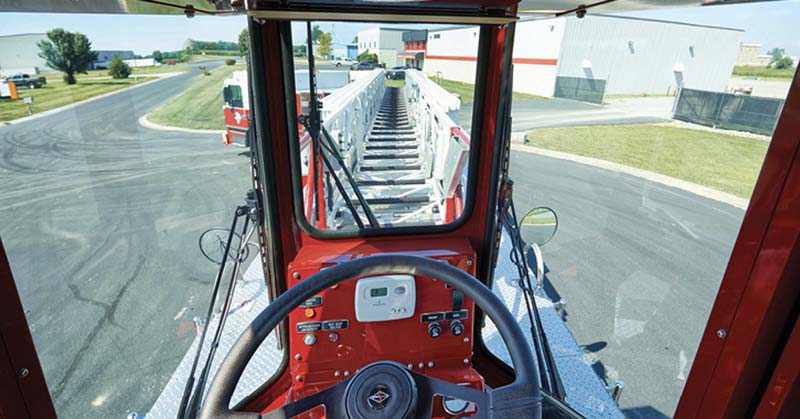
2 The tiller operator’s view from the Ladder Tower tiller cab.
The QX-100 is a 100-foot tiller with no prepiped waterway that allows for a more compact and shorter wheelbase trailer as well as a 14-foot outrigger spread, with an overall travel length as short as 55 feet, Hummer points out. The AH-105 model has a 105-foot ladder with a prepiped waterway, which can handle a 1,500-gallon per minute (gpm) flow, a longer trailer, additional compartmentation, and a 16-foot jack spread, he says. Both aerials are rated at a 500-pound tip load and are available in a quint option carrying up to 300 gallons of water with hose storage provided out of the ground ladder storage area at the rear of the trailer.
Hummer notes that both models of TDA that Spartan ER makes have a tiller cab that features enhanced visibility for the tiller driver. “The glass in the tiller cab is positioned in a 45-degree angle on the left and right sides to give improved visibility not only to the front but also both sides of the cab,” he adds.
Robert Triche, aerial sales manager for Ferrara Fire Apparatus, believes that it’s not only large cities that are ordering TDAs these days but also fire departments in suburban areas.
“They’re putting a dent in rear-mount aerial sales,” Triche says. “A lot of suburban departments are facing roundabouts and apartment complexes with tight access roads where they can’t get in a 100-foot rear-mount aerial. A TDA is much more maneuverable and a very attractive alternative, especially when you consider the bonus of the expanded storage options and the large ladder complement capacity.”
Triche says Ferrara builds its tillers on the Inferno chassis powered by diesel engines up to 605 horsepower (hp), on the Ultra chassis with power up to 500 hp, and the Igniter chassis with power up to 450 hp. Bodies on Ferrara’s tillers are formed aluminum with upper compartments up to 27½ inches deep and a transverse lower compartment beneath the ladder tunnel.
Ferrara’s TD-100 model has a 100-foot vertical reach and a 92-foot 10-inch horizontal reach and no prepiped waterway, while the TD-101 has a 101-foot vertical reach and a 94-foot 2-inch horizontal reach and carries a prepiped waterway. The TD-100 has a 500-pound tip load both dry and flowing 1,000 gpm through a 3-inch hose and a removable ladder pipe, while the TD-101’s tip load is 500 pounds dry and 500 pounds flowing 1,500 gpm through the prepiped waterway. Both models use a steel four-section aerial ladder that has a minus-two-degree to plus-75-degree operational envelope.
Pete Hoherchak, senior product manager for KME, notes KME has seen an uptick in orders and purchases of TDAs, both dry versions and with pumps and tanks. “I think the uptick has to do with the capability of a TDA,” Hoherchak observes. “It’s a very maneuverable truck, and with a short wheelbase tractor, wherever the tractor goes, the trailer can follow in its footprint. In addition, a TDA has a great equipment carrying ability. Where the NFPA (National Fire Protection Association) says an aerial has to be able carry 2,500 pounds of equipment, a TDA can carry twice that amount as well as a very large ground ladder complement.”

3 KME built this 100-foot TDA that has a 315-inch-long trailer for the Atlanta (GA) Fire Rescue Department. (Photos 3-4 courtesy of KME.)
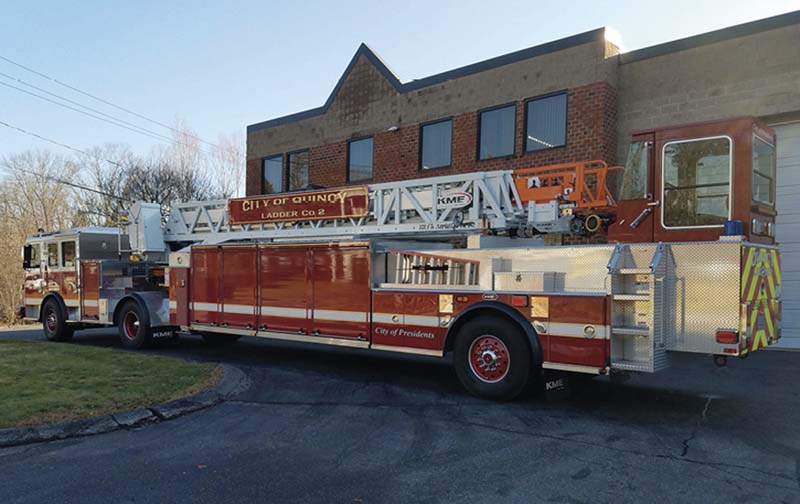
4 The Quincy (MA) Fire Department had KME build it a 101-foot TDA with a pump, water tank, and prepiped waterway.
Hoherchak says that KME makes two models of tillers. One is a 100-foot aerial without a prepiped waterway that has a 315-inch-long trailer. The second is a 101-foot TDA with a prepiped waterway, a 344-inch wheelbase, and a 332-inch-long trailer. He notes that the Los Angeles County (CA) Fire Department runs 100-foot KME tillers, while KME 101-foot TDAs are in use by the Santa Barbara (CA) Fire Department with a 2,000-gpm pump and 250-gallon stainless steel water tank as well as by the Somerville (SC) and Honolulu (HI) Fire Departments.
“KME has done a lot of engineering on the ride quality for the tillerman,” Hoherchak points out. “We found that putting the tillerman 105 inches behind the rear axle delivers the best ride quality, plus we only build our tillers with air ride suspensions on the tractor and trailer.” He adds that KME’s tiller aerial ladders are four-section 100,000-psi steel and have two H-style jacks with a 14-foot-wide spread. “KME was one of the first manufacturers to put a Hendrickson STEERTEK™ NXT axle on the chassis and worked with them to adapt it for our trailer too, which increased its cramp angle between 7 and 10 degrees,” Hoherchak says.
Jennifer Bloemer, senior business development manager for Pierce Manufacturing Inc., notes that in the 1990s, Pierce was building mostly medium duty tillers with 250-pound tip loads until around 2000, when it developed a heavy-duty TDA with a 750-pound dry tip load and 500-pound wet. “Now our tillers can flow up to 1,500 gpm and can handle wind speeds of 35 to 50 miles per hour, depending on the product,” Bloemer says. “These are standard features on our 100-foot and 107-foot tillers, along with a multiplex system, an auto bedding feature, and collision avoidance where the aerial will not be allowed to contact the cab or body.”
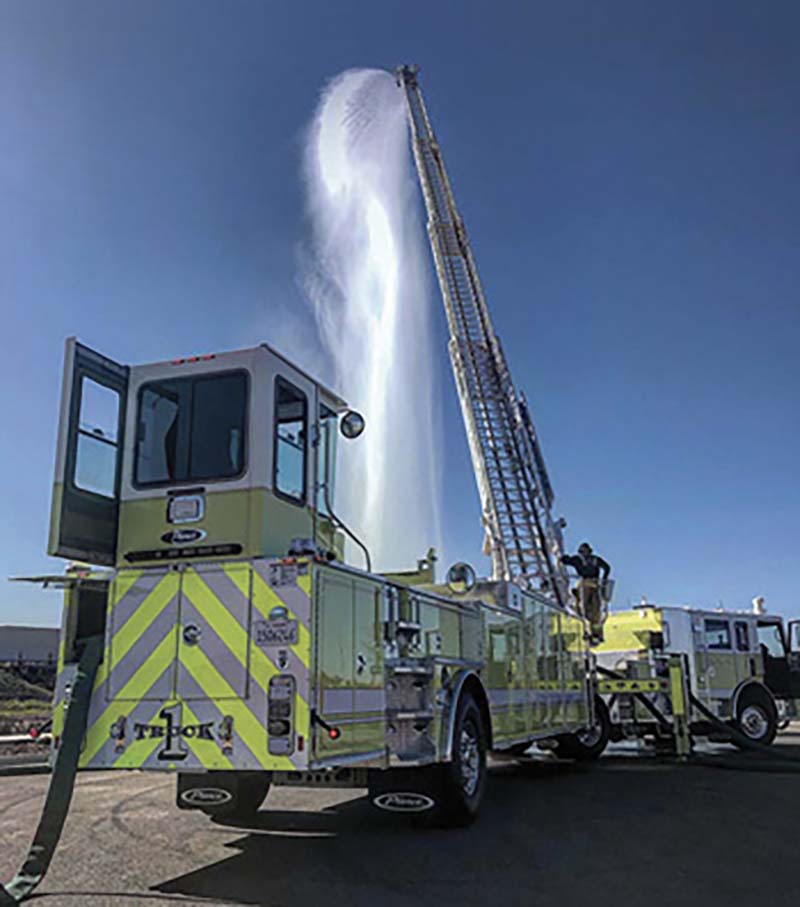
5 This Pierce Ascendant tiller has a 500-pound tip load wet and is flowing 1,500 gpm. (Photos 5-6 courtesy of Pierce Manufacturing Inc.)
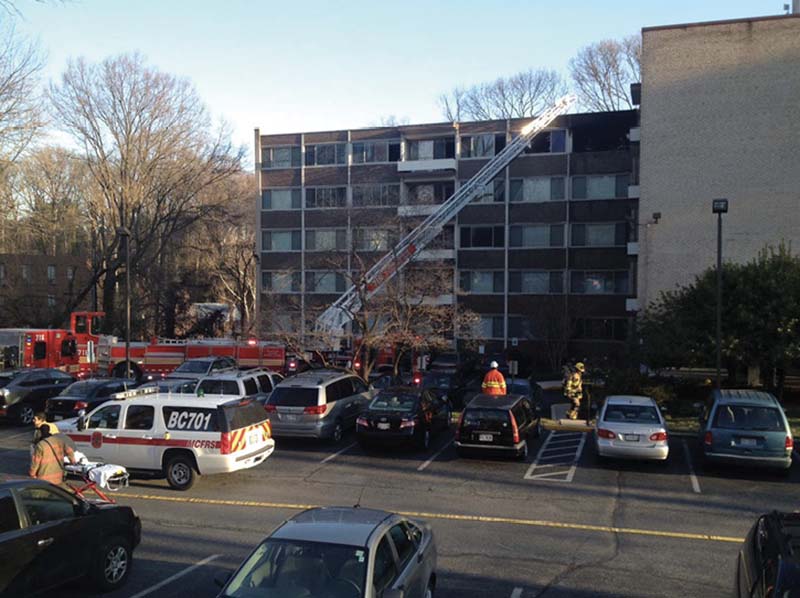
6 This Silver Spring (MD) Volunteer Fire Department tiller built by Pierce Manufacturing is operating in tight quarters at a six-story apartment fire.
Chris Breaker, Pierce’s aerial sales product specialist, points out that Pierce’s TDAs have a single set of H-style jacks located at the front of the trailer behind the tractor. “The jack spread is based on the tip load,” Breaker says, “going from a maximum of 17 feet to a minimum of 14 feet. With our Ascendant tiller, the device is much lighter, giving the tiller a lower center of gravity, and that also means that drivability and braking are enhanced. We’re also seeing more pumps and tanks on tillers than in the past, and we can cross mount the pump behind the tractor with the tank on top of it to minimize the tractor wheelbase or mount a PUC pump instead.”
Breaker adds that maneuverability, compartmentation, and ladder storage are the chief reasons fire departments choose to run a tiller. “Our tillers have up to 60-degree jackknifing capability and up to a 14-degree break-over angle between the tractor and trailer,” he says. “We offer hosebeds on either side of our tillers, carrying from 300 to 500 feet of large-diameter hose, depending on how much compartment space the department wants to give up; our tiller cab has a wrap-around windshield for greater visibility and is available with sliding or swing-out doors. Some departments are requesting attachable pulley systems and tie-off bars for centering the load between the rails for rope rescue at the tip of their tillers.”
Ernie Young, Western region aerial specialist for Rosenbauer, says his company has seen an uptick in the TDA market, especially in California and other Western states. “Some of the single-axle rear mounts need a wider jack stance and can’t carry a full truck complement of equipment, which has caused some fire departments to go to tillers,” Young observes. “We’ve made some changes to our tillers, like shortening the overall length of the vehicle and adjusting the tiller cab to allow the vehicle to be more agile.”
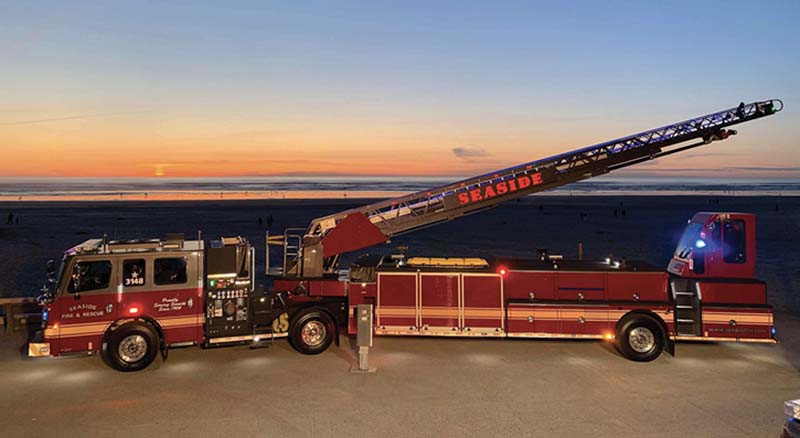
7 Rosenbauer built this TDA for the Seaside (OR) Fire and Rescue with the torque box, outriggers, chassis, frame rails, and ladder sections all hot dip galvanized to resist corrosion. (Photo 7 courtesy of Rosenbauer.)
Young points out that many Rosenbauer customers choose to have their tiller ladder sections hot dip galvanized to protect against corrosion. “We galvanize the torque box and outriggers on all our aerials as standard,” he says, “and galvanized chassis and frame rails are optional, as are the aerial sections. And we have our Smart Aerial Technology on our entire aerial line and have made cab and body collision protection dynamic now on tillers, so whether the tractor is angled right or left, the truck knows the location of the cab and prevents a collision with the aerial.”
Zach Rudy, director of sales for Sutphen Corp., says Sutphen debuted its first SLTDA 105 model at the Fire Department Instructors Conference (FDIC) International in April. “We built the TDA with no pump or tank for DeKalb County (GA) Fire Rescue,” Rudy notes. “This tiller has a 105-foot vertical reach, a 97-foot 7-inch horizontal reach, and a four-section extruded aluminum tubular ladder with a 3:1 safety factor.”
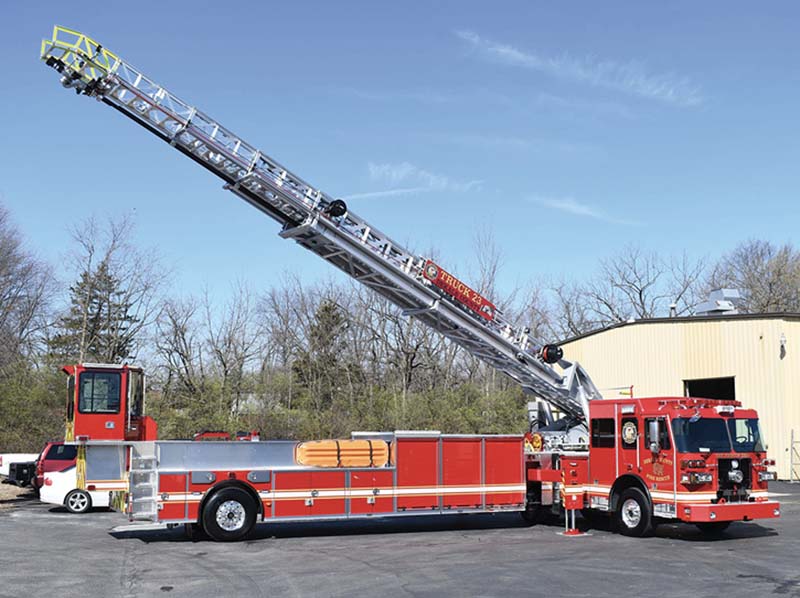
8 Sutphen’s newly-designed SLTDA 105 can jackknife 90 degrees and still set up safely. (Photo 8 courtesy of Sutphen Inc.)
Rudy says the tractor wheelbase is 153 inches, trailer wheelbase is 364 inches, travel length is 60 feet 5¼ inches, and overall height is 11 feet 8 inches. “This SLTDA 105 has a 15-degree angle of departure, can jackknife 90 degrees and still set up, has 558 cubic feet of compartment space, and 315 feet of ground ladders,” he says. The tiller is built on a Sutphen Monarch chassis with a 56-inch cab and 10-inch raised roof with seating for four firefighters. It’s powered by a 500-hp Cummins X12 diesel engine and an Allison 4000 EVS automatic transmission.
ALAN M. PETRILLO is a Tucson, Arizona-based journalist, the author of three novels and five nonfiction books, and a member of the Fire Apparatus & Emergency Equipment Editorial Advisory Board. He served 22 years with the Verdoy (NY) Fire Department, including in the position of chief.

